Dallas Opened Starter Modern Streetcar Line In April
Last month I told you about my Megabus trip to Dallas & back, see Thirty Hours on Megabus: St. Louis to Memphis to Little Rock to Dallas & Back. Today I want to tell you about one of the things I did in the week I was there: I rode their newest public transit line — it opened just two weeks before I arrived!
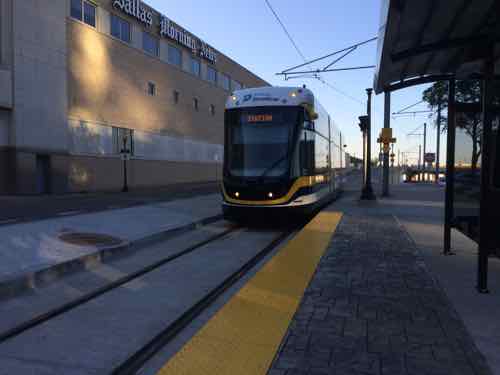
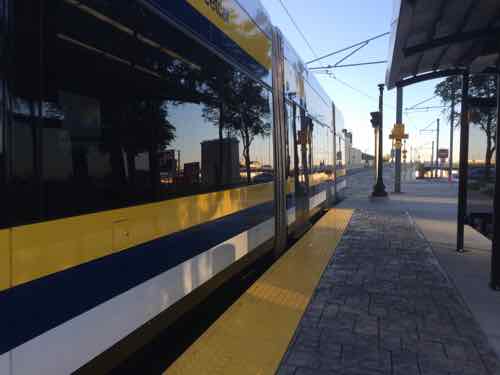
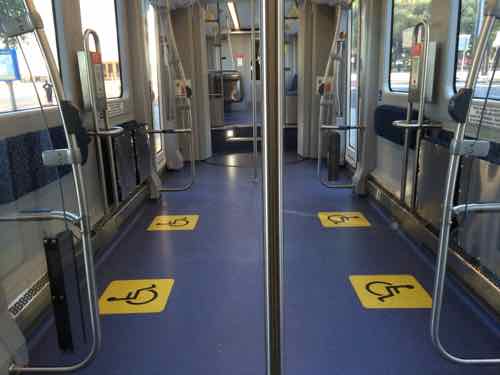
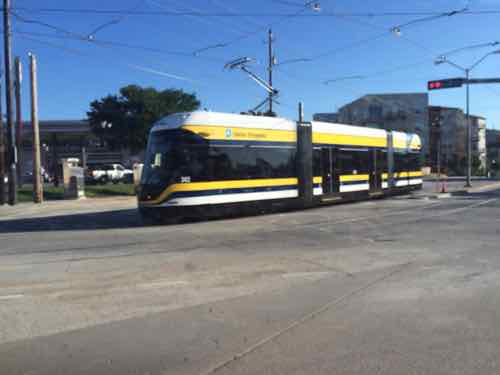
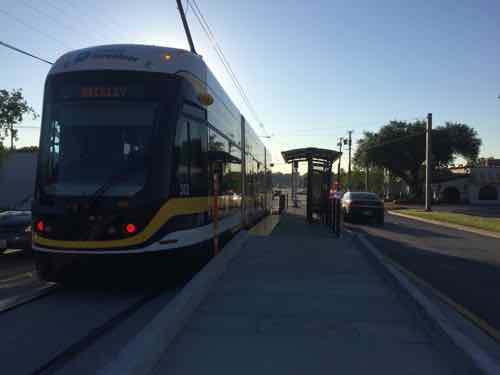
Dallas’ light rail system includes 4 lines, 62 station, a total of 90 miles (source). Our light rail, MetroLink, has two lines, 37 stations, and is 46 miles in total length (source). But the newest rail line in Dallas isn’t more light rail — it’s a modern streetcar line connecting downtown Dallas across the Trinity River to the Oak Cliff neighborhood:
More than five years in the making, the 1.6-mile line stretches from near Union Station downtown to the intersection of Beckley Avenue and Colorado Boulevard, near Methodist Dallas Medical Center in Oak Cliff.
A group of Oak Cliff leaders — including Luis Salcedo, Jason Roberts and Griggs before his council election – laid the project’s foundation as members of the Oak Cliff Transit Authority.
A $23 million federal stimulus grant in February 2010 brought the city, Dallas Area Rapid Transit and the North Central Texas Council of Governments together as project partners. The city owns the line, DART will operate it and the council of governments has been the funding conduit.
An additional $3 million in stimulus money, the allocation of regional toll-road revenue and other funding covered what has become a $50 million investment, with plans for expansion. (Dallas Morning News)
See DART Streetcar. Why didn’t they just build another light rail line? Or even a BRT (Bus Rapid Transit) line? A light rail line would’ve been far more expensive to build, it likely couldn’t have crossed a historic bridge over the Trinity River the way the streetcar does. It’s important to note the costs are for the initial system — over a historic viaduct crossing the now-flooding Trinity River. New extensions will be far less costly per mile.
From 2014:
Officials have spent almost a decade planning improvements to public transportation downtown. The matter became more urgent after Dallas Area Rapid Transit’s light-rail system reached critical mass. That 85-mile network connects downtown to the suburbs in all directions. The trains run along downtown’s edges, but not deep into its business, government and entertainment hubs.
“The conversation came up that LRT will take care of regional transportation. But what about in and around downtown?” Manoy said.
That’s when the idea of electric streetcars started to gain momentum. Like most transportation hopes, funding didn’t match ambitions. For years, planners navigated a series of route ideas, grant applications and shifting bureaucratic priorities. (Dallas Morning News)
Dallas planners see the streetcar connecting the dots — eventually a highly visible line in the heart of their downtown — connecting light rail to the CBD and other districts.
Of course, their streetcar had its critics. From 2013:
The problem is that Dallas sprawls too much to make rail-based streetcars a feasible solution. To solve our public transportation problem, Dallas ought to stop looking at models like Portland, Oregon, and look at cities that more closely resemble Dallas, places like Bogota, Colombia. Bogota has become a darling of the new urbanism crowd in the last decade thanks to its development of a Bus Rapid Transit (BRT) system.
Don’t be thrown by the B-word. Rather than a snaking web of indecipherable bus lines, like Dallas currently has, BRT systems use designated lanes, timed traffic lights, and painted ground areas to give pedestrians visual understanding of where routes go. BRT vehicles are faster, more comfortable, and more reliable than buses. And here’s the best part: for the cost of the Oak Cliff streetcar, Dallas could build a complete BRT system covering the entire city.
Roberts likes the idea of a BRT system in Dallas, but he says it has to be perfect or it won’t work, pointing to Los Angeles’ BRT attempt, which hasn’t had the same impact as systems in Bogota and Ottawa, Ontario. (D Magazine)
So I got to ride it just two weeks after opening, I’ve also seen where it’ll be extended to.
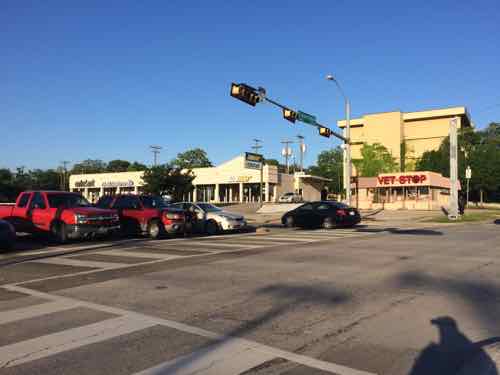
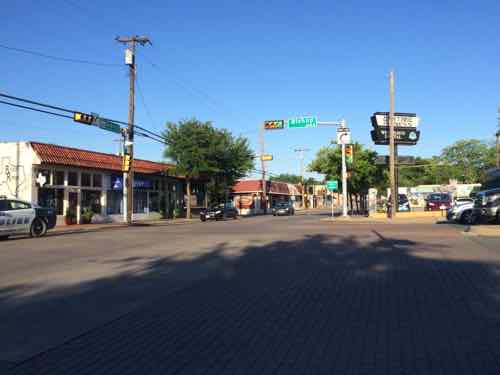
The area is charming — once you get to it!
The Bishop Arts District is home to over 60 independent boutiques, restaurants, bars, coffee shops, theaters and art galleries. Located in the heart of North Oak Cliff, one of Dallas’ most unique neighborhoods. A historical shopping district full of great finds, good eats, and good ole Oak Cliff charm! The Bishop Arts District is made up of many independently-owned shops and eateries that maintain various hours. While many of the shops stay open late on the weekends to provide a fun shop, stroll, and eat environment for visitors, the Bishop Arts District is populated with many independently-owned businesses, so please contact them directly for their hours of operation. Wine Walks are held 3-4 times a year and on 1st Thursdays of a given month. (Bishop Arts District)
I took the free D-Link bus back downtown. For now the streetcar is also free, operating weekdays only. Once extended it’ll have longer hours and weekend service.
Again, Oak Cliff is very close to downtown Dallas but it’s geographically separated by the Trinity River — in the news lately because of the flooding:
- Swollen Trinity causes road closures, evacuations
- Update: Rising Trinity River begins to impact businesses south of downtown Dallas
To my knowledge the streetcar line is dry, but the D-Link bus route might be impacted by road closures due to high water. The good thing about Dallas is they actually expand their transit systems, so I look forward to returning every few years to see the resulting development — if any.
— Steve Patterson
One, it’s $56.9 million, not $50 million – http://www.apta.com/resources/hottopics/circulators/Documents/Downtown-Dallas-Streetcar-Fact-Sheet.pdf . Two, let’s do the math – 1.6 miles with 4 stops and 2 vehicles for $56.9 million – that’s $6735 a foot, $560 an inch and $14.2 million per stop! A regular transit bus costs, what, $400,000? An articulated one, $700,000? Yeah, it’s cool technology, yeah it might “spur development”, but let’s get real – the core reason we support public transit is to MOVE PEOPLE. For $56.9 million, Dallas could have acquired between 80 and 150 boring-but-new buses and provided service to far, far more riders!
Did you miss in the post that Dallas already has a free bus shuttle (D-Link) serving the area? As I noted, the initial line was the most complicated (read costly) part of the future network.
Downtown it’ll help with the “last mile” issue light rail there and here faces.
Yes, I saw that they “already [have] a free bus shuttle (D-Link) serving the area”, but I didn’t want to point out the absurdity of creating a redundant system for millions of dollars more. A streetcar “MAY” help with urban redevelopment, but for the purpose of moving people, “the ‘last mile’ issue light rail there and here faces”, a bus is a far more cost-effective and useful solution. In my analysis, above, it comes out to a 50 to 1 difference. Even if it were a 10 to 1 difference, it still wouldn’t make much financial sense. Dallas’ two-car streetcar system offers service every 20 minutes. With buses, that could run every 5 minutes, or even every two minutes, for the same or less money. Once you get past the “different is cool” part of modern streetcars (the first few rides), frequent service trumps everything else!
My guess is Dallas knows the reality — it’s easier to get so-called “choice riders” on a system with rails vs rubber tires.
While in Denver, their busiest line is the 16th Street Mall shuttle, running BUSES every 70 seconds at peak times. There are plenty of “choice riders”, especially since its both free and frequent (and not on rails and not even air conditioned!) . . .
A 1.25 mile shuttle on one street within a downtown business district isn’t the same as a something running 5+ miles, connecting neighborhoods.
As your post states, this line is 1.6 miles long, not 5+, and more than half of the distance is on a viaduct over a riverbed. The point is that 20 minute frequency is far different than 5 minute or 70 second. If you can walk out the door and know that the vehicle will arrive within a minute or two, it becomes a very real alternative for ALL riders, even choice riders. If you work in one neighborhood and want to grab a bite in the other neighborhood over your lunch hour, 20 minute frequency is usually a deal breaker – most of us don’t have the luxury of having more than an hour off. If you live in one neighborhood and work in the other, or if you work in one neighborhood and have to get to a meeting in the other, missing a streetcar (or a bus), and having to wait 20 minutes for the next one, means you’ll likely end up being late (unacceptable).
Yeah, we can “plan ahead”, “know the schedule”, and mold our lives to match the system (we do that with airlines), but most of us, “choice riders”, do have the option of driving the 2-5 miles instead of walking or using transit. If your goal is to get people to embrace mass transit, the focus needs to be on creating a system that works well for multiple destinations, and that boils down to allocating limited resources wisely. Spending $50-60 million on a “starter line”, along with. I’m guessing, at least another $50-100 million to complete the remaining 3.4 miles, with, at most, a half dozen vehicles, when the same money can be spent putting several HUNDRED buses on the street, is a pretty simple choice in my mind – better coverage and more frequency is a bigger priority than “rail”.
“Paraphrasing a former mayor of Los Angeles, Hensher tells CityLab there’s an overwhelming perception ‘that buses are boring and trains are sexy.’ That mindset complicates the discussion of mass transit plans in growing metros: though advanced bus systems can perform as well or better than streetcar or light rail systems for less money, people would rather have trains. In previous work, Hensher has called this emotional preference a ‘blind commitment’: ‘The main point is that the enthusiasm (almost blind commitment) for LRT [light rail] has caused many to overlook the potential for more cost-effective bus-based systems and even simpler improvements to bus services that do not require dedicated right of way.'” http://www.citylab.com/commute/2015/02/the-myth-that-everyone-naturally-prefers-trains-to-buses/385759/?utm_source=SFFB
1) New “starter” lines are often short. Dallas, unlike STL, has a good track record of expanding transportation — highways & light rail. It’ll soon be much longer.
2) The frequency & hours are temporary until it has expanded. Once expanded it’ll have longer hours, run more frequently, and no longer be free.
People in Denver gripe about the disconnect between the trains to Union Station and the trains to downtown. Really. Despite the FREE MallRide.
Let’s use cars as a way of moving people. The Kia Forte is the least expensive sedan sold in the US at just under $16,000. The most expensive is the Bentley Mulsanne at over $335k.
In May the average new car was over $33k http://www.usatoday.com/story/money/cars/2015/05/04/new-car-transaction-price-3-kbb-kelley-blue-book/26690191/
That’s twice the price of two Fortes!
In May Kia sold 8,584 Fortes. Meanwhile Ford sold over 61k new F-150s in the same month, The #10 vehicle (Ford Fusion) sold 31,325 units.
People don’t pick the cheapest option!! I know you think you’re being rational but you’re actually being penny wise & dollar foolish.
You’d build a system that looks great on a spreadsheet, but is otherwise little used. Get a piggy bank for those pennies!
The D-Link is the bus you rode back on in Dallas. “‘Rail brings people into downtown; D-Link takes them to the doorstep of their destination,’ DART President/Executive Director Gary Thomas said.” https://www.dart.org/about/inmotion/january14/1.asp
I’m not advocating for “the cheapest option”, I’m advocating for rational decision making. The new streetcar and the exsting D-Link (attempt to) serve the same population. They’re both “free” (to riders), funded by multiple sources and operate on the same route. But there are differences:
Operating hours – streetcar, 5:00 am – 7:15 pm; bus, 11:00 am – 11:30 pm.
Operating days – streetcar, Monday-Friday; bus, Monday-Saturday.
Frequency – streetcar, every 20 minutes; bus, every 15 minutes.
Number of stops – streetcar, 4; bus, 37.
I’ll repeat, the best way to get more people to CHOOSE to use transit is to make it EASY! Even when the streetcar is extended to to its full, planned length, it will serve far fewer locations than the D-Link does today. Spending $5 millon to buy a dozen more buses would allow DART to increase service from every 15 minutes to every 5 minutes AND allow it operate from 5:00 am – midnight, 7 days a week. Instead DART and other political entities are spending 10-20 times as much to duplicate existing service and to degrade frequency, not improve it!
If the streetcar were twice as expensive as the bus and/or if it provided new service (not partially duplicating existing service), a rational argument can be made for investing in the intangible benefits that a streetcar might provide. Using your automotive analogy, I’ll argue that most people spend what their budget will allow. Sure, as riders, if both are “free”, both will be embraced by the riding public, and yes, irregular riders will favor the streetcar for its (current) novelty. My “rational” argument is coming from the capital and operations side. Every vehicle needs an operator, maintenance and fuel – spread those over more seats / passengers and you should get a lower cost per passenger. Every vehicle also has a capital cost – if one costs twice as much as another, you can only buy half as many (duh). And every transit system should be looked at and operated as an integrated system, not a random collection of routes and technologies. The only things a streetcar offers over the bus are a) electric operation and b) perception, that it’s “better” than the bus. It’s not quicker, more frequent or “cleaner”, but it sure does cost more to build the line and to purchase the vehicles, so hey, it’s gotta be good / better!
Route maps, for comparison:
https://www.dart.org/maps/pdfmaps/722map.pdf
https://www.dart.org/riding/dallasstreetcar.asp
I don’t need the maps –been there & rode both. As a person who regularly rides buses I think the D-Link is outstanding! I even told downtown St. Louis folks about it!
You seem to think their streetcar is stuck with the initial hours & frequency — it is not. Your rational decision making doesn’t account for this thing we call “human nature.” To really get people out of their cars you need rail or top-shelf BRT (which doesn’t exist in the U.S.).
No, I’m looking at what it costs to put service out on the streets. “A modern streetcar typically costs between $3.5 and $4.5M.”* A 40′ bus costs around $400,000, so a modern streetcar is more expensive, by a factor of 10, PLUS the cost of layng tracks and stringing power. If you have 10 times the number of vehicles, it’s easy to offer ten times the frequency (meaning a 2 minute wait, instead of a 20 minute wait). Or, you can “split the difference, provide 5 minute frequency (probably more than adequate to attract more riders), with 30% of the “new(ly available) buses”, on this route, PLUS provide 5 or 7 minute service ON TWO ADDITIONAL ROUTES!!!! I get it, you want a streetcar because it ain’t no bus. I’ll counter that it’s partly frequency, partly where the routes go and parly smart marketing.
Boulder, Colorado, is one of those “fun” neighborhoods, much like Oak Cliff, and they’ve done just fine in attracting choice riders with frequent service and creative marketing (and no streetcars). Pick your route, it can be the Hop, Skip or Jump (or Bound, Dash, Stampede or Bolt). Don’t worry about a schedule because the buses run every 5 or 10 minutes, 6:00 am – 11:00 pm. And because people “like you”, you neighbors, are riding, and have been riding for years, there is no stigma attached to riding the “bus”!
Buses and streetcars are both boxes on wheels, open to anyone willing to pay a token fare. Buses don’t get no love, especially in St. Louis, because of perception and prejudice AND because most of their schedules require the patience of Job! For most people and most riders (daily commuters), time is a luxury. Most of us are unwilling to double or triple our travel times just to use transit, be it a bus or a streetcar. The Loop Trolley is going to be a tourist attraction, albeit a very expensive, taxpayer-funded one. Unless and until it is merged into Metro’s larger transit system, there will be absolutely no reason for regular riders to embrace it, an d that will do more than anything else to kill in future investments in streetcars, modern or heritage, here, locally.
*http://www.railwaypreservation.com/vintagetrolley/vintagetrolley.htm
Nice fantasy, but thoae of us who’ve done books know the difference between a capital investment and operational expenses. Yiu forgot about labor — or do you plan to hiy driverless buses?
Nope, I haven’t forgotten about operational expenses – streetcars don’t run on wishes and fairy dust, either. And yes, more frequent bus service with smaller vehicles entails higher personnel costs than less-frequent service with larger vehicles. It’s all a matter of degree – the delta in cost between a streetcar (at $4 million) and a bus (at $400,000) is $3.6 million, and that, sir, will pay for a whole lot of union labor!
Harland Bartholomew thought he was being rational, but he too chose to ignore human nature and history. The result of his rational decision making was the disasterous 1947 comprehensive plan! https://www.stlouis-mo.gov/archive/1947-comprehensive-plan/
So, you’re going to blame the city’s comprehensive plan for all of the disinvestment in the city and all of the suburban sparwal in the surrounding counties?! The choices made here, in 1947, mirror the choices made in every major urban area, across the country. Some decisions, given the clarity of 20/20 hindsight, were poor ones, and some bordered on brilliant. I’m glad that you’ve never made some poor choices, because I sure have.
Streetcars are just one form of public transit, one of many options for shared boxes on wheels with regular stops (unlike private vehicles and taxis, that are both private and direct, thus the attraction of Uber). People don’t ride the bus because it’s slow, it involves waiting at a bus stop (often for 15-30 minutes) and because it’s perceived to be for “losers”: “‘Riding the bus carries a ‘shame factor,’ ‘ the researchers found. ‘Most of the choice riders would not consider using it, or if they did, they would feel ashamed and keep it a secret.’
“But what the local transit agency marketed as the “Orange Line” — really just a bus route in the San Fernando Valley with high frequencies on a dedicated right of way — managed to gain acceptance among ‘choice riders.’
“Focus group participants ‘used terms like the ‘train-bus’ or the ‘bourgeois bus’ to describe the Orange Line service,’ the researchers said. The Orange Line has repeatedly beaten its ridership estimates, and nearly half its riders have access to a car, compared with just a quarter on regular local bus routes in Los Angeles. That performance shows it is possible to overcome anti-bus bias with the right amenities and marketing.”
Yes, a streetcar can start to “shift the needle” on perceptions, but if it operates as infrequently as most transit routes do in the region, new texhnology ain’t gonna chage people’s opinions over the long haul. Fool me once, shame on you; fool me twice, shame on me . . .
http://www.nytimes.com/2015/02/10/business/to-save-on-rail-lines-market-the-bus-line.html?_r=1&abt=0002&abg=1
For reference, taxis are public transportation.
People misuse terms all the time.
“Public transportation” is available to any member of the public. So taxis are “public transportation” and so are commercial airlines and so is Amtrak.
“Mass transportation” transports a lot of people at once. So trains & buses and commercial airlines are mass transportation — including private charter buses — but taxis are *not* mass transportation.
I will point out that the Orange Line in Los Angeles is also nicknamed the “Orange Lie”; it is going to have to be converted to rail because it has too many riders to support with buses (the buses are full, and bunching, and they can’t lengthen them or add more) — which is what the rail supporters said would happen before it was built.
There’s also a distinction between public transit and public transporatation – public transit is provided a by a public transit agency, typically with significant tax subsidies and public oversight. It’s also great to see that the Orange Lie / Line is a success – that just reinforces the need for marketing and changing people’s perceptions about buses. Streetcars face the same challenges buses face (with finite capacity and the potential for bunching) – the biggest limitation with surface-running trains, on any sort, in urban areas, is block length – a stopped train (at a station or a stop) should not block an intersection – that was and is a constraint in Denver (limiting light rail to 4-car consists / trains), while station size / platform length is the constraint here, in St. Louis (limiting light rail to 2-car consists / trains).
Dallas has been very sensible in making the “streetcar” basically the same as the “light rail”.
Here, they needed to shoehorn it into a tight space, so it has some shared-with-cars lanes; and they needed to put stops more frequently than the light rail; and they didn’t need trains with as many cars… so it looks more “streetcar-like”, less “subway-like”. But otherwise they’re technically compatible. A good thing.
“Light rail” originated as a rebranding of streetcars/interurbans. They’re really the same thing thing. There’s a continuum from “all grade-separated, giant stations” to “all shared lane running, tiny curbside stops”, with everything in between existing. Boston’s Green Line is a dramatic example.
And I’ll repeat, exclusive of any right-of-way, rail infrastructure or operational costs, a “modern streetcar” vehicle costs ten times as much as a bus! $4 million versus $400,000. Dallas spent $56.9 million to get this line open. Of that, I’m guessing that $8 million went to the two vehicles purchased, $10-15 million for a dedicated maintenance facility, 10%, $6 million went to design, and the balance, $32-37 million went to rails and electrification. I have no problem with spending public money to deliver better service, I have major problems with spending significantly more money to deliver the same (or worse) service, which is the case, here.
I’ll also disagree on light rail just being a rebranding. Light rail is a descrption of the actual rail used. Light rail is lighter (per foot) than heavy rail (used for freight lines): http://www.rtd-fastracks.com/main_398 . and https://www.ltk.com/APTAbrochure.pdf . And, as you noted, there is a fuzzy middle, where interurban streetcars intersect with street-running light rail. From another “expert”, Jarrett Walker: “The term “light rail” was invented specifically for the contrast with “heavy rail,” which is a competing alternative for the same relatively long corridors. Light rail often makes closely-spaced stops right in downtown, and may thus serve a “streetcar” function there, but it does this mainly for the purpose of providing good access to people who want to use its higher-speed segments. I refer to streetcars/trams only when I mean local-stop services, designed to do pretty much what local buses do. (Such services are usually no faster or more reliable than a local bus.)” http://www.humantransit.org/2010/03/streetcars-vs-light-rail-is-there-a-difference.html
Streetcars in urban areas are no faster than the buses they (would) replace. Few people dispute that statement, since they operate in the same traffic and make the same stops. The one big “advantage” they offer is totally electric operation, which, depending on the generation source, can be “cleaner” than any internal-combustion engine, and, at the very least, moves the pollution source to another location. But the same thing can be, and is being, done with electric trolley buses – overhead wires provide the power, while the rest of the vehicle is nearly identical to a diesel or CNG vehicle: http://www.curbsideclassic.com/wp-content/comment-image/171545.jpg . The big difference (and savings) is avoiding the whole cost of installing and maintaining rail in city streets.
Finally, more good analysis: http://greatergreaterwashington.org/post/25409/how-to-tell-the-difference-between-streetcars-and-light-rail/
Technical details: http://www.modernstreetcar.org/pdf/circulator_trackway_report_final_3_30_07.pdf